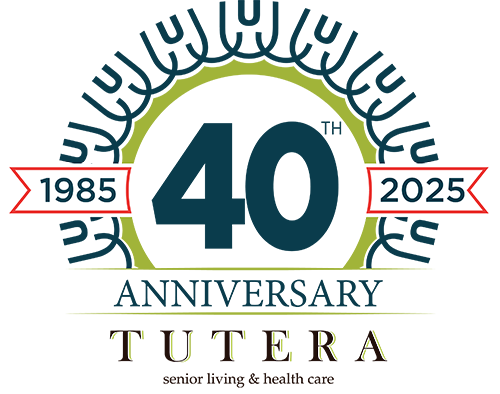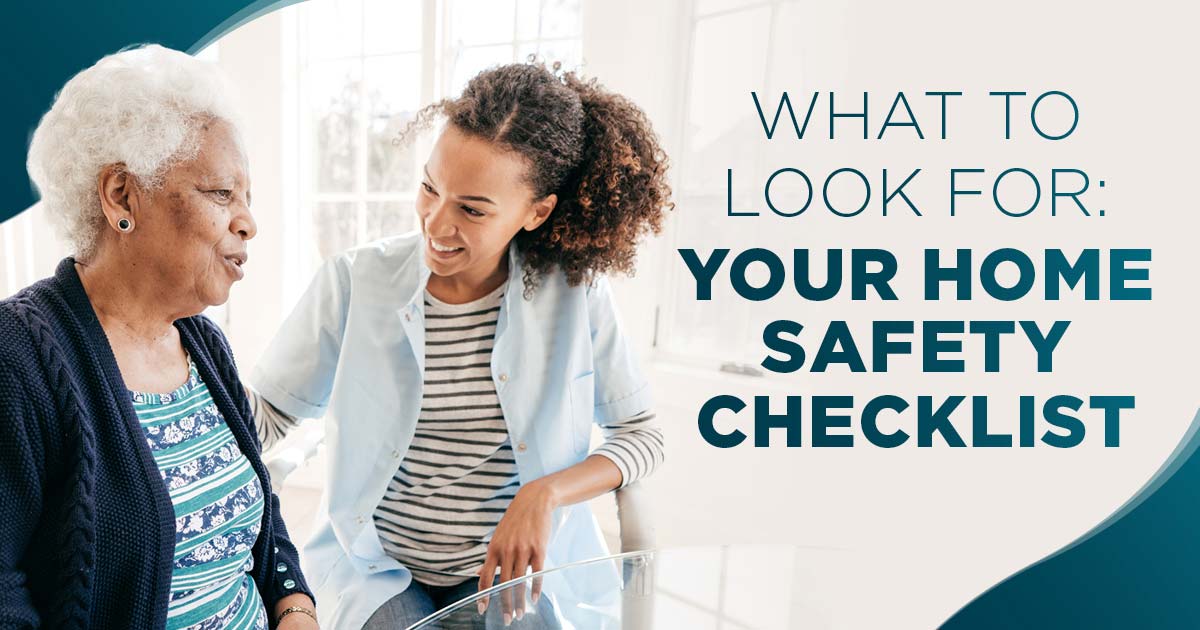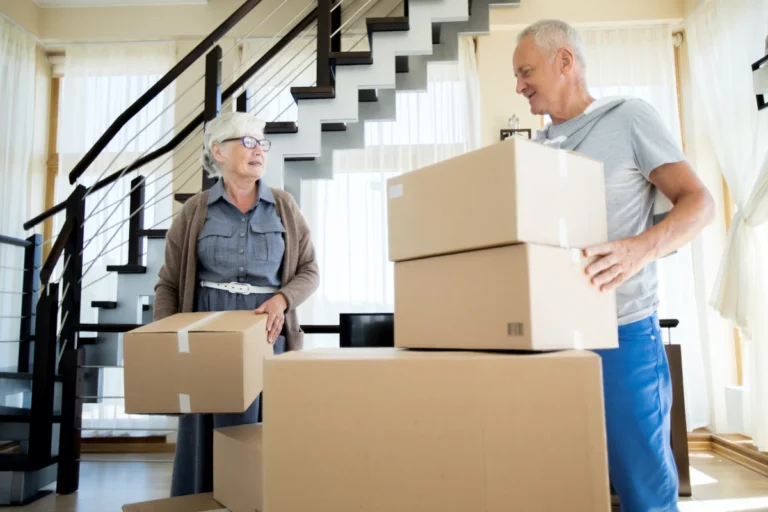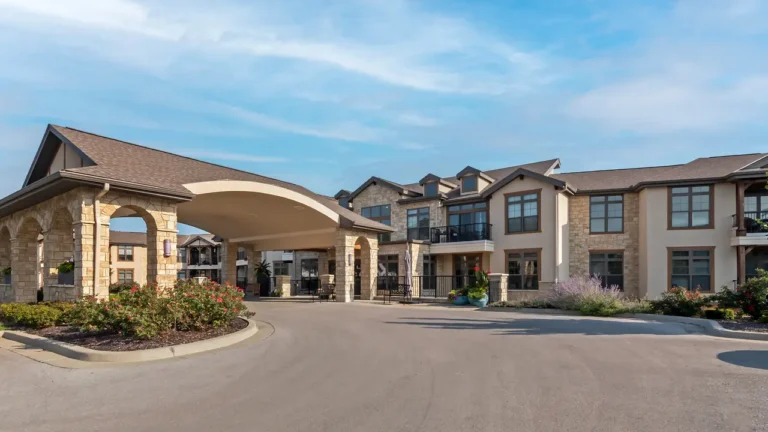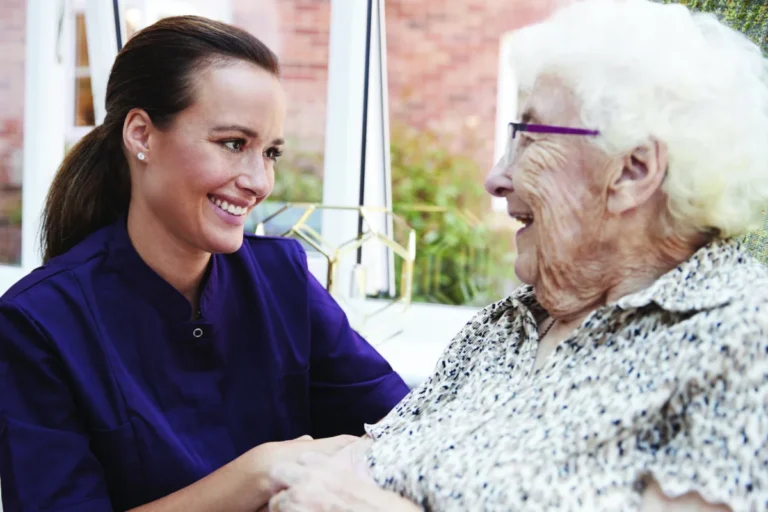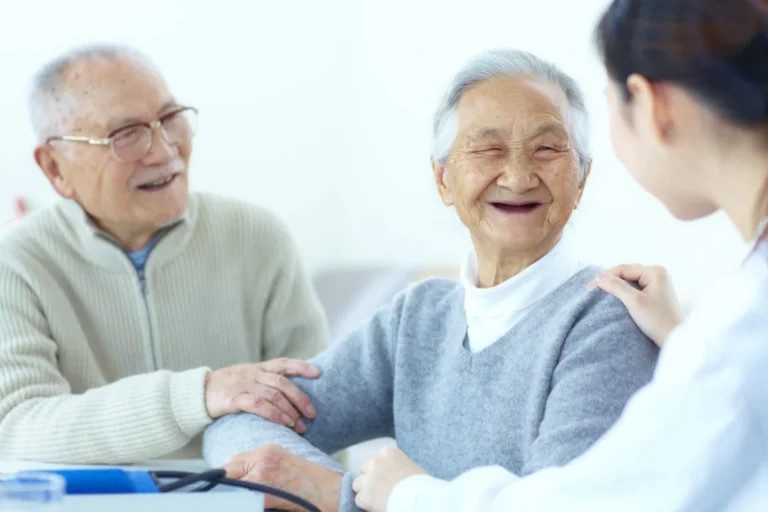Spending time with family during the holidays often reminds us how important it is to support the well-being of our older loved ones. Taking a closer look at their home environment helps ensure it stays safe and comfortable.
We’ve compiled a home safety checklist of things to look for in your older family members’ homes that alert you to potential dangers they may encounter, and we’ll also share measures you can take to help keep them safe and protected.
Why You Should Keep an Eye Out
As we get older, it’s easy for small details of our living space to go unnoticed: dirty and dusty surfaces, persistent odors, too much clutter and many other things can fly under the radar, especially for those who are losing their sense of sight or hearing.
While they may be able to manage living in their own home and may not need to move into a senior living community yet, they may have some difficulty with details like these.
When you visit family, it’s a great time to check and see what needs aren’t being met and prevent these smaller issues from becoming bigger problems. For example, if they have trouble keeping up with cleaning, you can arrange for cleaners to come in regularly to help. If they cover every surface, you can help them declutter.
By checking on your loved one’s living environment, you can easily correct any issues and prevent them from becoming ill or tripping and falling.
Your Home Safety Checklist
Here are some factors to look for and how to ensure home safety for elderly family members this season.
Increasing Number of Items and Clutter
Have surfaces around your family member’s home become crowded with things? From furniture to decorative items to everyday items that are easy to set down and forget about, these items can quickly take up more space than they should. Here are the questions you should ask when walking through to check for home safety:
- Are there any spare surfaces available in your loved one’s home? Are those surfaces clean?
- Are the rooms easily walkable? If they moved from a larger home previously, did they keep too much furniture?
- Are any pieces of their furniture weak, unstable or otherwise dangerous to use? Be sure to pay close attention to chair arms; people might use them for leverage.
- Is the furniture properly secured? Are there any cabinets, bookshelves, tables, televisions or media centers that seem unstable or wobbly?
The Risk
If you answered “yes” to any of the questions above, this could mean that your loved one is struggling to keep up with the clutter in their home, or they may not be able to delineate between things they should discard and things they should keep.
Having too much stuff can be a major safety alert for seniors. Too much clutter creates less space for your family member to move around, increasing their risk for slips, trips and falls. Not to mention, it can serve as a serious fire hazard.
What to Do
To improve this, you can sit down with your loved one and talk with them about their need to declutter to stay safe. You can establish a timeline and help them decide what to do with their belongings, such as keeping, donating or discarding them. Here are some resources to help you and your loved ones make these decisions:
- Tutera: Downsizing Made Easy
- Good Housekeeping: 7 Decluttering Methods
- House & Garden: How to Start Decluttering
If they have older, worn-out furniture, you can talk with them about purchasing more supportive furniture. While older furniture might have served them in the past, their functional needs can change as they age.
There is furniture specifically designed to help older adults move and relax in their home, accommodating their needs with slight alterations on classic designs. If they are unsure, you can take the time to shop with them to make sure they understand how these changes can help them in the future and find something that will make them happy. Here are some options for supportive furniture for older adults:
Trip and Fall Hazards
While you can remove furniture and other items that are cluttering walking spaces, there are other home safety factors you need to check when looking for trip and fall hazards. Here are some things to look at when considering elderly safety:
- Is there worn or buckled carpet in your loved one’s home?
- Are throw rugs secure to the floor, or do they slide around easily?
- Are there any electrical cords in the middle of walkways?
The Risk
While you may have memories of your loved one when they were strong and seemingly unstoppable, age does a lot to our bodies. Our bones and muscles become weaker, and our reflexes are not as fast as they used to be.
Small things that used to be fine may now send our loved ones for a fall, which can be painful and detrimental for their long-term health. In fact, falls are the leading cause of injury in older individuals and can even cause long-term disabilities.
What to Do
There are many ways to protect your family members from slips, trips and falls. You can remove throw rugs or secure them to the floor, remove or replace old carpet, and secure electrical cords or move them so they are no longer in walkways. Here are some resources to help you identify trip and fall hazards and provide the best fall protection for senior family members.
Bathroom Safety
From slippery tile to loose towel racks and tub walls we need to step over, there are plenty of opportunities to fall in the bathroom. Here is what to look for when evaluating home safety for elderly family members:
- Do bath mats have anti-slip backing (and does it actually work)?
- Do showers have anti-slip flooring or shower mats that prevent slipping?
- Are there professionally installed grab bars near showers, bathtubs and toilets? Are they secure and stable?
- Is the toilet seat high enough for safe use? Should you consider replacing it?
- Is the shower easily accessible?
- Is your loved one strong enough to stand in the shower for periods of time, or should you consider purchasing a shower seat?
The Risk
Bathrooms are one of the most common places for slips, trips and falls, right after stairs. More than 230,000 people injure themselves in the bathroom annually, and 13% of older adults living in homes without stairs fall in the bathroom. When going through your home safety checklist, many trip and fall hazards for our older family members exist in the bathroom.
What to Do
Keeping our family members safe is important. If you notice these hazards in their bathrooms, there are some top bathroom safety tips for seniors that you can follow to make their home safer.
- Install grab bars around toilets, showers and tubs
- Add anti-slip bath mats and rugs in the bathroom, especially by the shower, toilet and sink
- If needed, replace a regular bathtub with a walk-in shower
- Install a raised toilet seat
- Purchase a shower chair for your loved one to use while bathing
- Install anti-slip flooring in the shower, or add an anti-slip shower mat
Here are some additional resources to look at when looking at improving the bathroom for your older family members:
- Bath Fitter: How to Improve Bathroom Safety for Seniors
- AARP: 14 Bathroom Updates for Now and Later
- 101 Mobility: How to Improve Bathroom Safety
Lighting and Visibility
One thing to look at when visiting your loved ones is how well lit their home is. Some things to look at when walking through their home include:
- Are all light bulbs functioning and using the proper wattage?
- Are there any points in the home where walkways or common areas are dim or hard to see?
- Does your loved one already have a hard time seeing and need additional lighting?
The Risk
Many aspects of our health slowly decline as we age, and our eyes are no exception. While you can remove as many tripping and falling hazards as possible, not being able to see properly still increases the risk of falls. It’s not just that things become more and more blurry – we lose the ability to see up close, have trouble distinguishing colors and need more time to adjust to changing levels of light.
Eyesight is important for letting us know when things like our house are clean or dirty, when food has gone bad, when there is something possibly dangerous nearby and more. Making sure your loved one has proper lighting in their home helps prevent several injuries and illnesses.
What to Do
Here are some things you can add to your home safety checklist to improve your loved one’s home.
- Install bigger and brighter light fixtures in your loved one’s home
- Add adjustable lighting to help their eyes have an easier time adjusting from room to room
- Make sure all lights have working light bulbs with the proper wattage
- Alter the interior decoration to allow for more natural lighting
- Install night-lights in hallways, bathrooms and bedrooms as needed
Here are some additional resources to help you improve the lighting in your older family member’s home:
- Autonomous: What Types of Light Improve Your Vision
- Better Homes & Gardens: 15 Ideas for Better Lighting
- The Spruce: How to Light Your Home Like a Designer
- HGTV: Lighting Tips for Every Room
Poor Storage Areas
We all have stuff in storage, whether it’s holiday decorations, photo albums, memorabilia or seasonal clothing. While we’ve already addressed decluttering all the things your loved one puts into storage, we haven’t talked about the storage space itself.
Storage space can be in places that are already difficult to access – the top shelf in a closet, under the bed, on top of kitchen cabinets or behind doors. One thing to look at when evaluating trip and fall hazards is storage spaces and how easy it is for your older family member to use them. Ask yourself these questions:
- Do they need to use a step stool or ladder to reach storage areas?
- Do they need to get down on their hands and knees to reach the storage?
- Are certain storage areas still awkward to reach, even with a ladder or step stool?
- How heavy are the items they are storing?
The Risk
Having to get on a ladder or step stool can be a major safety alert for seniors. They can easily miss a step, lose their balance or pick up something too heavy and fall. In fact, among unintentional injury deaths, falling from a ladder is the #1 leading cause for those aged 60 and over. So, when looking to prevent injuries from falling, we need to look at ways to keep our loved ones safely on the ground.
What to Do
Here are some storage tips to provide the best fall protection for seniors and improve their overall home safety.
- If your loved one needs to use a ladder for storage, find new storage areas within the home, or dedicate a certain space that allows easier access for their storage needs
- If cabinets or shelves are too high, rearrange their space to make sure regularly used items are easily accessible
- For bulk storage, use multiple, smaller boxes, and pack them lighter so they are easier to pick up and carry around
Here are some resources to help you find better storage options for your older family members:
Fire Safety
Another item to check off your home safety checklist is making sure there are no fire hazards or flammable items in warm areas or places that are close to an open flame. Especially during the holidays, there are several important fire safety concerns your older family members might overlook, such as:
- Candles
- Extra lights
- Pine trees
- Portable space heaters
- Unattended cooking
However, there are still everyday fire hazards you should monitor. Some things you should look for include:
- Are smoke alarms and carbon monoxide detectors working? Do they have fresh and working batteries?
- Are smoke and carbon monoxide alarms loud enough for your loved one to hear?
- Are there multiple clear pathways to leave the house if there is a fire?
- Has a professional examined any fireplaces (whether gas or electric) and ensured they work properly?
The Risk
According to the U.S. Fire Administration, people aged 65 or older have a higher risk of dying in a fire. This is because of mental impairments, the use and improper storage of flammable substances, and possibly living with smokers can increase the risk of fire injury.
In fact, approximately 1,200 older adults die each year from fire, making it the sixth-most leading cause of death for those 65 and older. The risk of this only increases around the holidays, with 38% of all home fire deaths occurring in the months of December, January and February. So, when you visit your family during this time, it’s important to talk with them specifically about holiday fire safety and how to keep their home safe throughout the year.
What to Do
The first thing you need to do is talk with your family members about their habits and how they can prevent the risk of fire injuries in their day-to-day life. It’s important to remember that they are an active participant in maintaining their home safety and to talk with them rather than telling them what to do or changing things in their home without their permission.
However, here are a few changes you can suggest to help them reduce the risk of house fires:
- Schedule a time every year where you and your loved one replace the batteries in smoke alarms and carbon monoxide detectors.
- Make sure there are multiple clear pathways for escape in case there is a fire.
- Invest in a couple of small fire extinguishers, and place them in easy-to-access areas in your loved one’s home. Discuss with your loved one how to use them in case of fire.
- Reorganize flammable items around the house so they are at least three feet away from anything that gets hot.
- If your loved one smokes, talk with them about their habits, and make sure they know where in their home it is safe to smoke (e.g., do not smoke in bed or on the couch; instead, go outside).
- If your loved one uses electrical items like portable heaters or electric blankets, invest in versions of these that automatically turn off after a set amount of time.
- Make sure the house number is easy to read outside, even at night. This helps emergency vehicles quickly identify your home in case there ever is a fire.
- Make sure stoves, heaters and chimneys are clean and in proper working order. Schedule times to have these things regularly cleaned, replaced and inspected.
Here are some resources to help make sure your family member’s home is safe and secure:
- American Red Cross: Home Fire Preparedness
- U.S. Fire Administration: All About Home Fires
- Ready.gov: Home Fires
Stairway Safety
When looking at elderly safety, stairs are a hazardous zone in any older adult’s home. When visiting your loved one, ask yourself:
- Are the stairs well-lit and free of clutter?
- Are there handrails for the stairs? Are they secure and steady?
- Does your loved one have difficulty with mobility?
- Are the stairs wooden or carpeted? Are they slippery?
The Risk
In the UK, approximately 290,000 people experience injuries from falling down the stairs, and about 500 people die from these falls. Strength and balance control is a major issue with older adults, and because of this, they are prone to slips and trips – especially when using the stairs.
What to Do
There are many actions you can take to prevent your loved ones from falling down the stairs, including:
- Declutter any items that are taking up space on the steps.
- Add non-slip strips or carpet on wooden stairs to prevent slipping.
- Make sure the stairs are well lit. You can add motion-sensor lights that clearly illuminate the steps.
- If there are handrails for the steps, make sure they are secure to the wall and easy to grip. If not, install some handrails for your loved one to hold on to.
- If you feel your loved one is weak or struggling with mobility, talk with them about stairlifts and other mobility tools that make moving up and down the stairs safer.
If you want to learn more, check out these resources to help improve home safety for elderly family members:
- AARP: 8 Ways to Make the Stairs Safer
- 101 Mobility: The Ultimate Guide to Stairlifts
- Elder: How to Make Stairs Safe for the Elderly
- Public Health Agency of Canada: 12 Steps to Stair Safety at Home
Unusual Temperatures
Do you ever walk into your loved one’s home and feel you’ve just walked into a sauna? Or does their house temperature feel normal, but you notice plenty of space heaters, blankets and warm clothing that they wear constantly? This might be a sign your loved one is struggling with feeling comfortable with typical temperatures. Here’s what to look for on your home safety checklist:
- Does your loved one always have the heat turned up in their home?
- Are they always wearing sweaters, jackets and warm clothing, even when the temperature is normal?
- Do they often need a blanket to keep warm or feel chilly without one?
The Risk
As we get older, our bodies become more sensitive to the environment, specifically around temperature. Often, older adults tend to feel colder and like to crank up the heat. However, studies have shown that it’s hard for healthy older adults to tell when they are too hot or when they are dehydrated.
When we get hot, our bodies produce sweat to cool us off. However, older adults’ ability to sweat diminishes, causing them to hold more heat for longer amounts of time. This can increase major health risks as the heart struggles to circulate blood, affecting older adults’ cardiovascular and immune systems.
What to Do
Figuring out the appropriate temperature can be a balancing act for older adults and their loved ones. For some, their internal temperature may be normal, but they can consistently feel cold. Here are some things you can do to make sure your loved one is safe and comfortable:
- Consider a smart monitoring system.
- Keep a thermometer close by, and if you are concerned your loved one is too cold or hot, use it to make sure their internal temperature is normal.
- Talk with your loved one about staying hydrated. Work with them to help them find ways to stay hydrated if they don’t enjoy drinking water.
- Make sure all the thermostats in the home are working properly and are easily accessible.
Check out these resources to learn how to keep your loved one warm and hydrated:
- Tutera: Best Electrolyte Drinks for Seniors
- Tutera: Simple Tips to Support Health and Wellness With Hydration
- National Institute on Aging: Cold Weather Safety for Older Adults
- Carrier: Recommended Thermostat Settings for Summer and Winter
Bedroom & Mattress
We all hate replacing our mattresses, but we need to do it eventually. However, it’s easy to forget how long it’s been since you replaced your mattress, and it’s most likely the same story for your elderly family members. When going through your home safety checklist, look at:
- How long has it been since your loved one replaced their mattress?
- When sitting on the bed, are your loved one’s knees above their hips, or are they roughly the same height?
- When your loved one sits on the bed, do their feet touch the floor?
- Does your loved one struggle to get in and out of bed?
The Risk
As we become older, our bodies become more sensitive to many things – pain, temperature and anything even a little uncomfortable. Experts suggest replacing your mattress every 10 years, as it gradually loses support. An unsupportive mattress can cause several health concerns, including:
- Poor sleep
- Soreness and aches
- Worsening asthma or breathing issues
- Getting too hot or too cold
- Slower mental and emotional function
Not to mention, old mattresses can harbor dust mites, mold, bacteria and other allergens that cause more serious health issues.
What to Do
We’ve already talked about looking at geriatric furniture options, but there are also options for beds and bed frames. Here are some changes you can add to your home safety checklist:
- Purchase a new mattress
- Look at geriatric bed frames, or frames that sit lower to the floor
- Look at getting adjustable bed frames that allow your family member to sit up easily or adjust how high their head is in bed
- Add mobility aids to your loved one’s bed to help them easily get in and out of bed
Here are some additional resources to help make sure your family member has the best mattress and bed possible.
- Sleepopolis: Best Mattress for Seniors
- Good Housekeeping: Top 5 Adjustable Beds
- Carex: 8 Devices to Help Elderly Get Out of Bed
Food & Medication Safety
We’ve all either done it ourselves or know someone who ate something that expired and got a mild case of food poisoning. Managing what you eat and what medications you take is hard enough, but for older adults, it can be much more difficult.
Here are some safety alerts for seniors to look out for:
- Is there any expired food or medication?
- Does your loved one protest trying to throw away food that is expired?
- If your loved one freezes meat and other food, how long has that food been in the freezer? Does your loved one remember?
- Does frozen meat have freezer burn?
- Are food and medication properly stored?
The Risk
For medications and food, it’s very important to make sure your loved one can keep track of what is safe to consume and what is not safe to consume. According to the USDA Food Safety and Inspection Service, adults 65 and older are at a higher risk of being hospitalized and even die from food-borne illness. In fact, older adults are four times more likely to get listeria infections, which is the leading cause of death of food poisoning in the U.S.
Older adults are also more likely to forget to take their medications, or forget that they have taken their medications and accidentally overdose. For some medications, it may not cause adverse health effects. However, for other medications, it can cause serious illness and even death.
What to Do
If you are finding issues with food and medication management in your loved one’s home, then here is what you do to keep them protected:
- Throw away expired food.
- Dispose of expired medications at an approved medication disposal facility (you can also check local ordinances to see the regulations for throwing away expired medications).
- Take some time to stock your loved one’s pantry and fridge with replacement products as needed.
- Make sure medications are current and properly stored.
- Be aware of possible medication interactions and side effects. If needed, make a list for yourself and your loved one.
- Purchase some medication management tools to help your loved one remember to take their medication (and remember if they’ve already taken it).
Here are some helpful resources to improve elderly safety around medication and food consumption:
- FDA: 5 Medication Safety Tips for Older Adults
- Sinai Health: Managing Medications for Seniors
- Strategies and Tools for Supporting Appropriate Drug Use in Older Adults
- Medication Management Tools
Technology & Safety
While many older adults aren’t very tech-savvy, we provide resources like phones and tablets to help them stay connected. Some older adults can even manage laptops and computers.
However, there are risks that can come with technology. Scams run rampant, and unfortunately, our older family members don’t know what to watch out for to protect their finances and identities online. Here are some things to keep an eye out for when it comes to elderly safety online:
- Does your loved one have a cell phone or tablet?
- Does your loved one log in online to pay any of their bills? Do they use official sites with secure domains?
- Where does your loved one save their passwords? Are their passwords secure?
- Has your loved one ever shared their online passwords with others?
The Risk
For many older adults, they’ve saved their money their entire lives so they can enjoy retirement in comfort. However, because they lack online literacy, older adults are disproportionately impacted by scams and fraud, and many easily lose their entire savings in just minutes.
In 2024 alone, seniors lost $12.5 billion to scammers and fraud, increasing up to 25% in just one year. Adults in their 70s report losing a median of $20,000 in investment funds and a median of $1,000 of checking account funds. Sadly, experts expect that scams and fraud will only grow.
What to Do
When looking at improving elderly safety for your loved one’s online activity, there are certain actions you can take. We recommend:
- Make sure your loved one has all your family members’ phone numbers saved under their names. If there are any strange numbers sending messages asking for them to send money, delete them.
- Talk with your loved one about signs to look out for.
- Talk regularly with your loved one about their online activity. If needed, set up remote family controls on their social media to monitor their activity and prevent their information from being stolen.
Here is more information about common scams to look out for and how to stay updated on the latest information on frauds, scams and elderly safety online:
- FBI: Common Elder Fraud Scams and How to Report
- National Council on Aging: The Top 5 Financial Scams Targeting Older Adults
- UC Health: Elder Fraud
- FBI Elder Fraud Pamphlet
About Tutera
In our Tutera communities, such as those within Rolling Meadows Senior Living and The Gardens at Park Pointe, home safety is our top priority. Our team members recognize trip and fall hazards, potential health issues, and many other factors that could put our residents at risk. We work with families to make sure loved ones are happy, comfortable, and healthy – whether they are in independent living, assisted living, or memory care.
If you are considering senior living for your loved one, or thinking of transitioning into senior living yourself, then we encourage you to check out any of our Tutera communities. You can either explore nearby communities or call our team to ask whatever questions you might have. We’re here to help you find the best living solutions for you and your family.
Keep Your Loved Ones Safe
When visiting your loved ones, it’s important to know what to look for on your home safety checklist. This way, you can easily stay alert for potential dangers, risks and health hazards and ensure your older family members are in a space that is safe and comfortable for them to be in.
